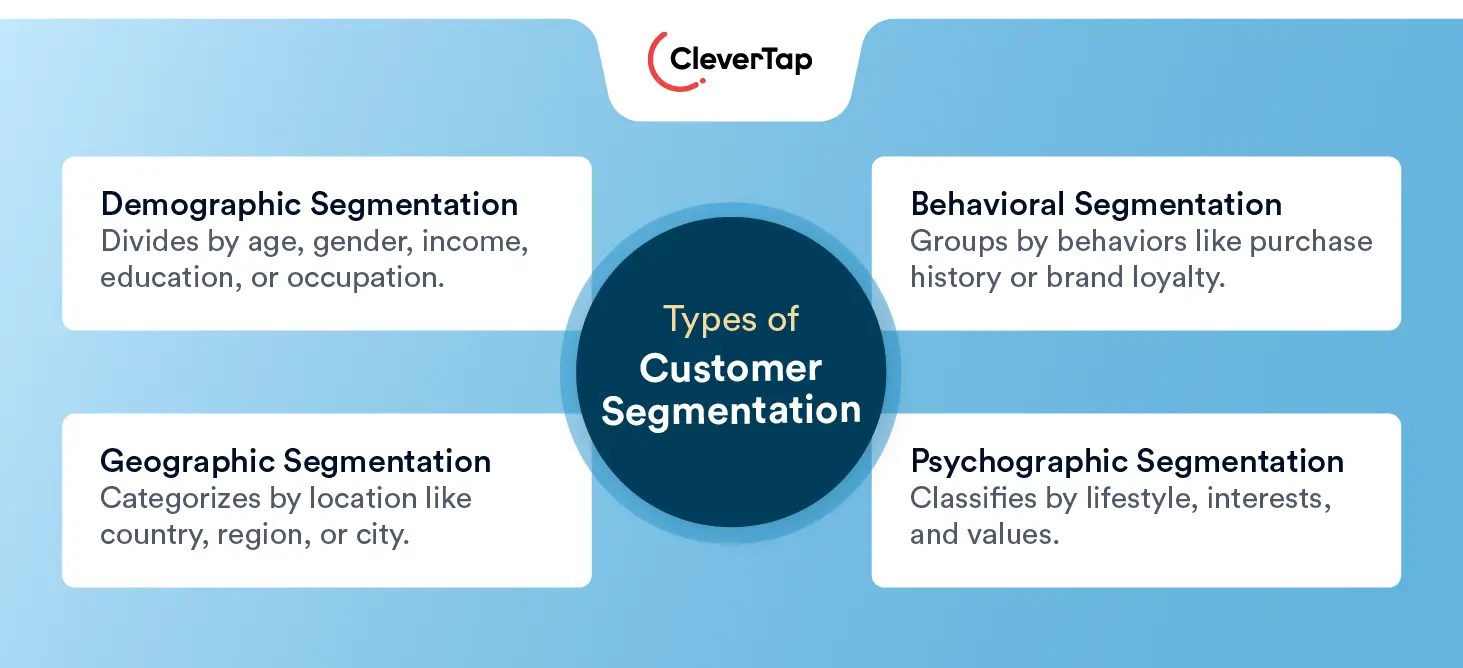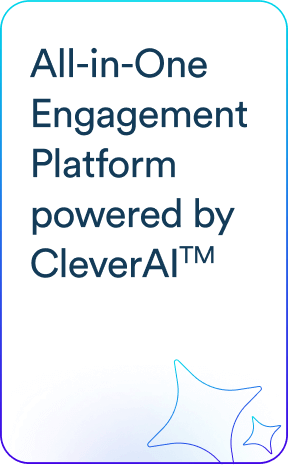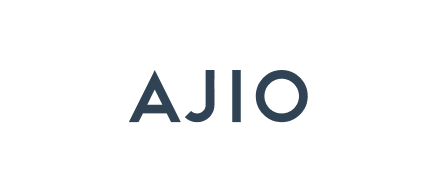Customer segmentation helps you truly understand your audience and tailor your marketing efforts with laser precision. This article will cover 21 customer segmentation examples to help you divide your customer base into meaningful segments and create impactful campaigns that resonate with the right audience.
Customer segmentation groups existing customers by demographics, behavior, or interests, enabling more personalized and targeted marketing that drives higher engagement and conversions.
While both customer and market segmentation target audiences effectively, their focus differs: customer segmentation refines efforts for current buyers, whereas market segmentation divides the broader landscape (e.g., by geography or income) to uncover new growth opportunities.
The Four Main Categories of Customer Segmentation
There are an endless number of ways you can segment your audiences, but most of them fall into one of these four main categories of customer segmentation:

- Demographic segmentation divides the market based on variables such as age, gender, income, education, and occupation. This method helps businesses tailor their marketing strategies to meet the specific needs and preferences of different demographic groups. A luxury car brand might target high-income professionals, while a children’s toy company focuses on young parents.
- Geographic segmentation categorizes customers based on their location, such as country, region, city, or neighborhood. For instance, a clothing retailer might promote warm winter coats in colder climates and lightweight summer clothes in tropical areas.
- Behavioral segmentation groups customers based on their behaviors and decision-making patterns. Imagine organizing a library based on the genres people most frequently borrow. This includes purchase history, product usage, and brand loyalty. A coffee shop might use behavioral segmentation to target frequent coffee drinkers with loyalty rewards, while casual visitors receive occasional promotional offers.
- Psychographic segmentation classifies consumers according to their lifestyles, interests, and values. It is akin to forming clubs based on hobbies and interests. For example, a fitness brand might target health-conscious individuals who value an active lifestyle, while a tech company markets new gadgets to early adopters who love innovative products.
21 Customer Segmentation Examples
1. Value-Based
Type: Psychographic

Value-based segmentation focuses on the value customers seek from a product or service, such as quality, price, or convenience. Picture a store with sections labeled “budget-friendly,” “premium quality,” and “quick and easy.” A tech company might market high-end gadgets to customers, prioritizing quality while promoting budget devices to price-sensitive customers, ensuring that each segment receives offers that align with their values.
2. Seasonal
Type: Behavioral

Seasonal segmentation targets customers based on the time of year or specific holidays. It’s like switching wardrobes for summer and winter. Retailers use this to promote holiday-themed products during Christmas or back-to-school supplies in late summer. By aligning marketing efforts with seasonal behaviors and trends, businesses can ensure their campaigns are relevant, timely, and engaging.
3. Transactional
Type: Behavioral

Transactional segmentation groups customers based on their purchase history and transaction behaviors. Imagine a grocery store organizing customers by the items in their shopping carts. This method helps businesses identify high-value customers who frequently make large purchases and offer them exclusive deals and rewards, enhancing customer loyalty and encouraging repeat business.
4. Generational
Type: Demographic

Generational segmentation divides the market by age cohorts, such as Baby Boomers, Gen X, Millennials, and Gen Z. It’s similar to organizing a party with themed areas for different age groups. A fashion retailer might use this approach to market retro styles to Gen X and trendy outfits to Millennials, catering to each generation’s unique tastes, preferences, and cultural influences.
5. Lifecycle Stage
Type: Behavioral

Lifecycle stage segmentation categorizes customers based on their stage in the customer journey, from awareness to loyalty. A software company might send introductory content to new users while offering advanced tutorials and loyalty rewards to long-term customers, ensuring continuous engagement at every stage of the customer lifecycle.
6. Cultural
Type: Demographic

Cultural segmentation groups customers based on cultural factors such as ethnicity, religion, or language. Imagine curating a festival with different cultural booths. A food brand might promote kosher products to Jewish communities or offer Spanish-language services to Hispanic customers, ensuring cultural relevance and inclusivity and enhancing the connection with diverse customer bases.
7. Interest-Based
Type: Psychographic

Interest-based segmentation targets consumers based on their hobbies and interests, like creating fan clubs for different TV shows. For example, a travel company would offer adventure packages to thrill-seekers and relaxing beach vacations to those interested in unwinding. This method allows businesses to create highly personalized and engaging offers that resonate with specific interests and passions.
8. Firmographic
Type: Behavioral

Firmographic segmentation in B2B markets involves categorizing businesses based on characteristics such as industry, company size, and revenue. Software companies tend to tailor their services differently for small startups compared to large corporations, ensuring that each group receives offerings that match their specific operational needs and scalability requirements.
9. Technographic
Type: Behavioral

Technographic segmentation classifies customers based on their technology usage and preferences. Imagine a tech expo with booths catering to varying levels of tech-savviness. A software company might target tech enthusiasts with advanced features while offering user-friendly options to less tech-savvy customers, ensuring that products meet the diverse technological needs of different user groups.
10. Engagement
Type: Behavioral

Engagement segmentation groups customers based on their interaction levels with a brand, akin to dividing a classroom by student participation. Online platforms often target highly engaged users with premium content and occasional users with reminders and incentives. This segmentation ensures that engagement strategies are tailored to each group’s activity level, promoting higher overall engagement.
11. Loyalty
Type: Behavioral

Loyalty segmentation focuses on customers’ loyalty levels to a brand, similar to a rewards program with bronze, silver, and gold tiers. Many retailers offer exclusive discounts and early access to sales for their most loyal customers, fostering long-term relationships and encouraging continued patronage. This method helps reward and retain high-value customers, improving your customer retention rate.
12. Occasion
Type: Behavioral

Occasion-based segmentation targets customers based on specific events or situations, like planning themed parties for different occasions. A greeting card company might market wedding cards to couples getting married, birthday cards to friends and family, and holiday cards during festive seasons. This approach ensures that marketing efforts are timely and relevant to the specific occasions customers are celebrating.
13. Channel-Based
Type: Behavioral

Channel-based segmentation groups customers by their preferred communication channels, akin to setting up different booths for email, social media, phone calls, and in-person interactions. Businesses can tailor their marketing efforts to ensure messages are delivered through the channels customers prefer, enhancing engagement and response rates by meeting customers where they are most comfortable.
14. Benefit
Type: Psychographic

Benefit segmentation divides customers based on the specific benefits they seek from a product or service, like a gym with sections for cardio, strength training, and relaxation. A beauty brand might market anti-aging products to those seeking youthful skin and eco-friendly products to those valuing sustainability. This approach ensures that marketing messages resonate with the specific benefits each segment values most.
15. Role-Based
Type: Behavioral

Role-based segmentation categorizes customers based on their roles within an organization or family, akin to organizing a workplace by departments. B2B companies often target HR managers with employee wellness programs, while home improvement stores offer DIY kits to family handymen. This method ensures that products and services are relevant to the specific roles and responsibilities of each customer group.
16. Health
Type: Psychographic

Health segmentation focuses on customers’ health needs and preferences, similar to a wellness center with areas for nutrition, fitness, and mental health. A health food store could market gluten-free products to those with celiac disease and protein-rich foods to athletes, ensuring that products meet the specific health requirements and preferences of their diverse customer base.
17. Usage Rate
Type: Behavioral

Usage rate segmentation divides customers based on how frequently they use a product or service, like a gym, categorizing members as daily users, weekly users, and occasional visitors. For instance, a streaming service might offer premium subscriptions to heavy users who watch content daily and free trials or discounts to light users to encourage more frequent engagement, tailoring offers to match usage patterns.
18. Customer Status
Type: Behavioral

Customer status segmentation categorizes customers based on their relationship with the brand, akin to differentiating new students, current students, and alumni. Online retailers typically send welcome offers to new customers, loyalty rewards to regular shoppers, and win-back campaigns to previous customers who haven’t purchased in a while. This ensures targeted strategies for each customer status.
19. Income-Based
Type: Demographic

Income-based segmentation groups customers based on their income levels, similar to a shopping mall with sections for luxury brands, mid-range stores, and discount outlets. A travel company might market high-end vacation packages to affluent customers while offering budget-friendly options to those with lower disposable income, ensuring relevant and appealing offers for each income segment.
20. Education Level
Type: Demographic

Education level segmentation divides customers based on their educational attainment, like a library organizing events for different reading levels. Online course providers typically offer advanced certifications to highly educated professionals while promoting basic skills training to those with less formal education, effectively catering to the learning needs and capabilities of each group.
21. Attitudes
Type: Psychographic

Attitudinal segmentation classifies customers based on their attitudes, beliefs, and perceptions towards a product or service, akin to understanding different fan bases for a movie. A sustainable fashion brand might target environmentally conscious customers with eco-friendly messages, while another segment might be attracted to the brand’s stylish designs, ensuring tailored marketing messages for each attitude.
Check out the 10 best customer segmentation tools and see which stands out as the right fit.
Customer Segmentation Analysis Best Practices
Now that you’ve explored customer segmentation examples, let’s look at some best practices to ensure success. To effectively divide your user base and achieve key business goals, it’s important to follow these foundational principles. Follow these rules of thumb for an effective customer segmentation strategy.
- Know your users. What acquisition channels do they come from? Why and how do they use your app? How does your solution solve their pain points? Learn as much as you can about your current customer base and their app usage habits.
- Don’t get too specific. Communications expert Frank Luby advises his “three-adjective rule”: if you can’t describe your segment in three adjectives, it’s too complicated. Segments like “users who follow ‘80s rock playlists” are more actionable than “users who listened to ‘Bohemian Rhapsody’ in the last 24 hours.” After all, segments need to be big enough that targeting them is worth the effort.
- Set prioritized goals. Once you’ve created a few segments, define a goal for each. This way, you can guarantee that your user segments are actionable and that your marketing efforts and engagement campaigns are tied to specific, measurable business goals.
- Test and optimize. What’s working for key groups of customers? What isn’t? A/B or multivariate testing is essential for refining your marketing strategy and meeting (even exceeding!) campaign goals.
- Revisit your segments. You can’t take a set-it-and-forget-it approach to segmentation. Your users will evolve over time – both who they are and how they use your app. Revisit your segmentation strategy periodically and look for shifts in size, behavior, and engagement. Does your current messaging still resonate with each segment, or do you need to refresh your approach?
Download our comprehensive customer engagement guide
Creating Your Own Customer Segments
Customer segmentation is a powerful tool that can significantly enhance your marketing strategy by ensuring your messages are personalized and relevant to specific groups. CleverTap stands out as a one-stop-shop customer segmentation tool, making it easy to understand and categorize your customer base through its robust analytics and real-time data capabilities.
CleverTap is designed to make segmenting and engaging your audience easy, no matter how many users you have. Features like RFM analysis automatically create user segments for you, from champions to inactive users, and give you instant insights into the best channels and tactics to engage each one.
By leveraging advanced features like CleverTap’s Clever.AI, you can maximize your segmentation efforts, optimize customer journeys, improve engagement, and ultimately drive higher conversion rates and loyalty. With these 21 customer segmentation examples, you have a comprehensive list to refine your segmentation strategy and take your marketing efforts to the next level.
Supercharge your growth with CleverTap’s All-in-one customer engagement platform
Shivkumar M 
Head Product Launches, Adoption, & Evangelism.Expert in cross channel marketing strategies & platforms.
Free Customer Engagement Guides
Join our newsletter for actionable tips and proven strategies to grow your business and engage your customers.















































